Solid Oxide Fuel Cell Market by Type (Planar, Tubular), Component (Stack, BOP), Application (Stationary, Portable, Transport), End User (Commercial & Industrial, Data Centers, Military & Defense, Residential) & Region - Global Trends & Forecasts to 2028
Solid Oxide Fuel Cell Market Size, Share, Growth Report & Forecast
[231 Pages Report] The global solid oxide fuel cell market is estimated to grow from USD 1.4 billion in 2023 to USD 5.4 billion by 2028, growing at a CAGR of 31.0% during the forecast period. Supportive government policies and subsidies for R&D and rising adoption in applications such as power generation play a vital role in the growth of the solid oxide fuel cell market. Power generation accounts for ~40% of all CO2 emissions in Asia Pacific countries such as Japan, South Korea, and China. Using Hydrogen as a fuel for the power generation sector will reduce carbon emissions; the government in these countries aims to cut emissions by 40% & 39% in the commercial & residential sectors by 2030, respectively. Thus, there is expected to be increased adoption of stationary fuel cell systems in the power generation sector.
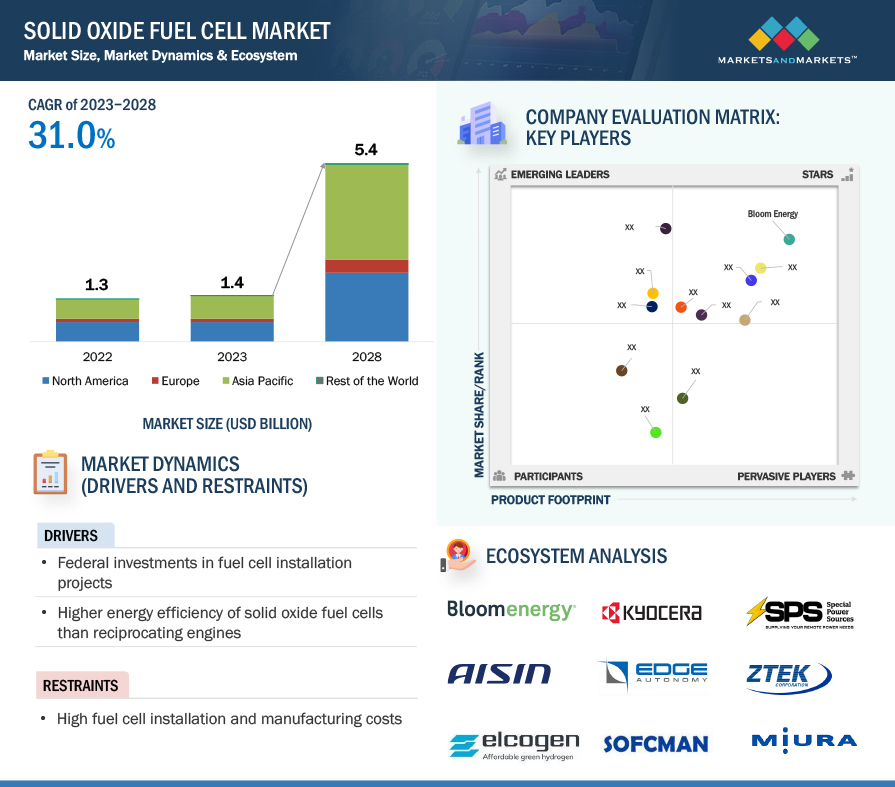
To know about the assumptions considered for the study, Request for Free Sample Report
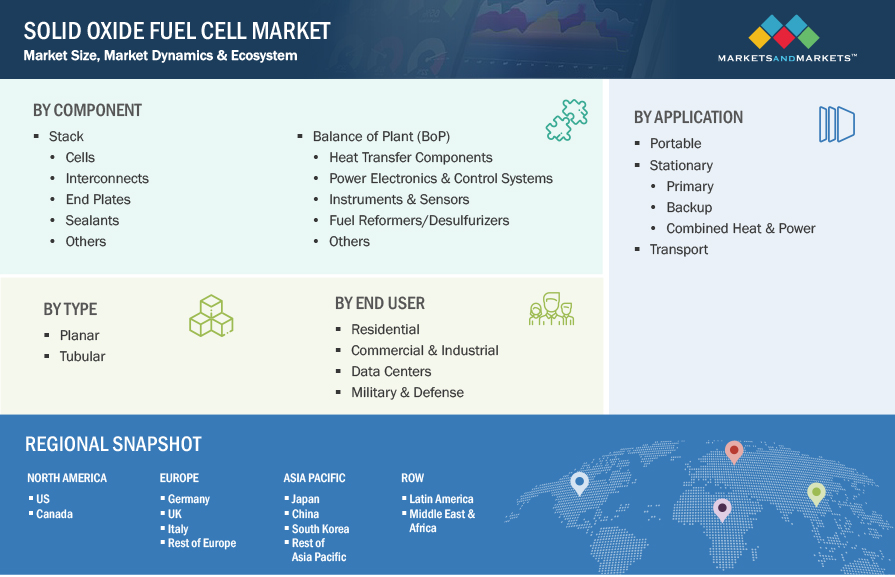
To know about the assumptions considered for the study, download the pdf brochure
Solid Oxide Fuel Cell Market Growth Dynamics
Driver: Introduction of stringent carbon emission norms
SOFC is a clean technology incorporating conventional fuels, such as natural gas. They have a negligible level of carbon emissions than other types of natural gas-fired technologies used typically for power generation. This is due to the direct conversion of chemical energy into electrical energy without a combustion process. One of the key drivers for the demand for low-emission technologies, such as SOFC, is stringent carbon emission norms prevalent across multiple regions. North America, Europe, and Asia Pacific have formulated several strict regulations to limit carbon emissions from power generation operations. Such regulations also specify the permissible diesel generator noise levels to reduce noise pollution caused by diesel genset operations. Different countries/regions have their own set of regulations and policies.
For example, the US Department of Energy (DOE) has announced plans to offer up to USD 32.5 million in federal funding for cost-shared R&D to promote SOFC technology in 2021. Furthermore, California's Self-Generation Incentive Program (SGIP) provides generator rebates to assist both present and emerging distributed electricity generation. California had set a USD 1 billion budget for SGIP till 2024; the most recent development is the Energy Division's SGIP Renewable Generation workshop in November 2020.
Restraint: Availability of alternatives
SOFCs have a lower market share in the entire fuel cell market due to the restricted number of end-use applications they can serve. Proton exchange membrane fuel cells (PEMFC) dominate the industry, accounting for at least 65% of total market share due to its versatility in a variety of end-use applications. PEMFC and direct methanol fuel cells (DMFC) are more suitable for military applications, particularly in portable and unmanned systems, due to their lower operating temperatures. Other technologies, including molten carbonate fuel cells (MCFC) and phosphoric acid fuel cells (PAFC), compete with SOFC technology in the United States, Japan, and South Korea. MCFC technology faces significant competition from SOFC in terms of installation cost per kilowatt and applications, such as combined heat and power (CHP) and power.
Opportunities: Increasing electricity consumption in data centers
Data centers and the commercial and industrial sectors are among the most rapidly expanding end consumers of power generation systems in the US. Data centers use a lot of power. Furthermore, data centers require constant electricity to prevent the loss of vital data. The International Energy Agency (IEA) estimates that data centers would consume around 240-340 TWh of electricity in 2022, accounting for nearly 1-1.3% of global electricity demand. Because of the high power consumption, data centers seek cost savings by implementing distributed power generation, notably fuel cells. Fuel cells, especially SOFCs, have already experienced significant growth in the US. Its adoption for data centers by Google (US), IBM (US), and Equinix (US) has stimulated growth at the fastest rate. Currently, the overall SOFC adoption by data centers is still minuscule with respect to the total data centers in the US, making it one of the most lucrative businesses. In the military sector, stationary and portable power generation by SOFCs is on the rise. Additionally, the need for noiseless and efficient power generation for military applications creates an opportunity for SOFCs in this segment. Military & defense end users are increasingly adopting SOFC-powered devices for portable applications.
Challenges: Fuel cell degradation and carbon dusting
Solid oxide fuel cells encounter many challenges due to their high operating temperatures of over 1,000°C. Maintaining temperature is strongly tied to performance, and the likelihood of material degradation is a major concern. The variation in oxygen partial pressures necessitates distinct materials for the anode and cathode, making material stability critical. Maintaining the stability of solid electrolytes in low-oxygen partial pressures and reducing the possibility of electrolytes reacting with other components are additional important considerations. The likelihood of degradation, caused by variations in the size and shape of nickel particles due to sintering and morphological changes in the anode, generates stress and leads to fuel impurities and cracking during redox cycling.
Also, maintaining stability in interconnects in oxidizing and reducing environments, as they are exposed to anode and cathode, is challenging. Ceramic interconnects provide higher stability than metallic interconnects but at a higher cost. One of the concerns while using ceramic interconnects is carbon dusting. Finally, ensuring the matching of the coefficient of thermal expansion of sealant with other SOFC components is also crucial. These material challenges associated with solid oxide fuel cells will likely pose a significant challenge for the SOFC market.
Solid Oxide Fuel Cell Market Ecosystem
Prominent companies in this market include well-established, financially stable solid oxide fuel cell manufacturers. These companies have been operating in the market for several years and possess a diversified product portfolio, state-of-the-art technologies, and strong global sales and marketing networks. Prominent companies in this market include Bloom Energy (US), AISIN CORPORATION (Japan), KYOCERA Corporation (Japan), MITSUBISHI HEAVY INDUSTRIES, LTD. (Japan), and MIURA CO., LTD. (Japan).
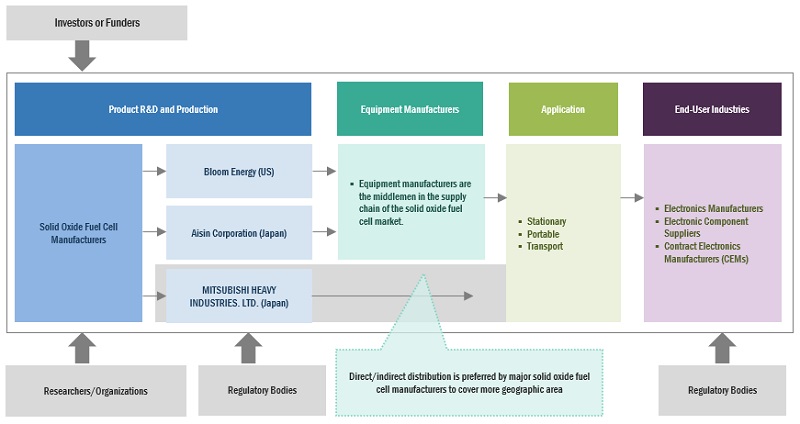
The planar, by type, is expected to be the largest segment during the forecast period.
This report segments the solid oxide fuel cell market based on type into two types: planar and tubular. The planar segment is expected to be the largest segment during the forecast period. Because of its compact structure, the planar solid oxide fuel cell demand is likely to be significant. As its construction is relatively simple, it is the most commonly used solid oxide fuel cell type. Planar SOFCs are extensively used in stationary power applications due to superior power densities and heavy system designs. The key players that manufacture SOFCs with planar geometry include Bloom Energy (US), Sunfire GmbH (US), SOLIDpower S.p.A. (Italy), and Convion Ltd. (Finland). Tubular SOFCs are suitable for portable applications due to their mechanical strength and rapid start-up periods. Even though planar geometry SOFCs are a more mature technology than tubular SOFCs, the increasing need for power-hungry portable devices is expected to drive the tubular SOFC market throughout the anticipated period.
By end user, the data centers is expected to be the fastest growing during the forecast period
This report segments the solid oxide fuel cell market based on end user into four segments: residential, commercial & industrial, data centers and military & defense. The data centers is expected to grow at the fastest rate during the forecast period. The market for solid oxide fuel cell the data centers sector is primarily driven by growing demand of reliable, and high efficiency power. Owing to the emerging need to decrease carbon emissions, various manufacturers are continuously investing in the solid oxide fuel cell market. Whereas commerical end-users accounts for largest share for the solid oxide fuel cell market. Solid oxide fuel cells are ideal for stationary building applications due to their high electrical efficiency, minimal emissions, and fuel versatility. They can convert a greater proportion of a fossil fuel's energy into electricity than combustion-based processes. They can also generate electricity using low- and zero-carbon fuels like hydrogen. As the need to minimize carbon emissions grows in the business sector, many firms are investing in the SOFC industry.
"Asia Pacific": The largest in the solid oxide fuel cell market"
In the solid oxide fuel cell market in 2023 - 2028, Asia Pacific is estimated to hold the largest market share, followed by North America and Europe. Increased urbanization and population have demanded considerable infrastructure development, driving rising electricity demand across the region. According to the Indian Electrical and Electronics Manufacturers' Association (IEEMA), India's energy generation capacity is predicted to expand from 200 GW in 2010 to more than 800 GW by 2032 to meet rising demand for power. As a result, power equipment production will require a massive investment of around USD 300 billion over the next 3-4 years, increasing demand for solid oxide fuel cells.
Asia Pacific countries enounter many energy-related problems, which has forced them to change their energy systems. Primary energy demands are projected to increase by 60% by 2035, due to expanding industry, urbanization and economic growth. Australia and China are looking to increase the role of hydrogen in order to reduce emissions from industrial processes, such as feedstock, ammonia, methanol production and transport. As the development of fuel cell technology improves, the utility sector acknowledges crucial activities, such as microgrid development.
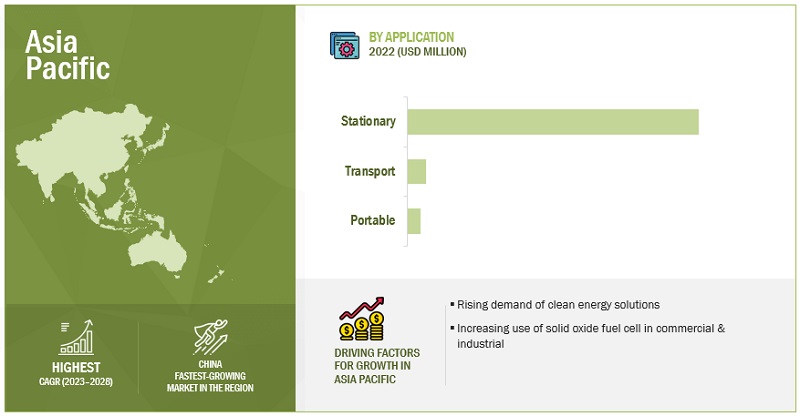
Key Market Players
The solid oxide fuel cell market is dominated by a few major players that have a wide regional presence. The major players in the solid oxide fuel cell market include Bloom Energy (US), AISIN CORPORATION (Japan), KYOCERA Corporation (Japan), MITSUBISHI HEAVY INDUSTRIES, LTD. (Japan), and MIURA CO., LTD. (Japan). Between 2018 and 2023, these companies followed strategies such as contracts, agreements, partnerships, mergers, acquisitions, and expansions to capture a larger share of the solid oxide fuel cell market.

Want to explore hidden markets that can drive new revenue in Solid Oxide Fuel Cell Market?
 Scope of the Report
Scope of the Report

Want to explore hidden markets that can drive new revenue in Solid Oxide Fuel Cell Market?

|
Report Metric |
Details |
|
Market size available for years |
2020–2028 |
|
Base year considered |
2022 |
|
Forecast period |
2023–2028 |
|
Forecast units |
Value (USD Million/USD Thousand) |
|
Segments covered |
Solid oxide fuel cell market by type, component, application, end user and region. |
|
Geographies covered |
Asia Pacific, North America, Europe, and Rest of the World |
|
Companies covered |
Bloom Energy (US), Mitsubishi Power (Japan), AISIN CORPORATION (Japan), Hitachi Zosen Corporation (Japan), Ceres (US), MIURA CO., LTD. (Japan), KYOCERA Corporation (Japan), Convion Ltd. (Finland), Elcogen AS (Estonia), SolydEra SpA (Italy), Watt Fuel Cell Corporation (US), h2e Power (India), Upstart Power, Inc. (US), FuelCell Energy, Inc. (US), Ningbo Suofuren Energy Technology Co., Ltd. (SOFCMAN) (China), WEICHAI POWER CO., LTD (China), Sunfire GmbH (Germany), ZTEK Corporation, Inc. (US), Special Power Sources (US), ADELAN (UK), Edge Autonomy (US), Robert Bosch GmbH (Germany), Doosan Fuel Cell Co., Ltd. (South Korea), POSCO ENERGY (South Korea), Cummins Inc. (US), Clara Venture Labs (Norway) |
This research report categorizes the solid oxide fuel cell market by type, component, application, end user and region.
On the basis of type:
- Planar
- Tubular
On the basis of component:
- Stack
- Balance of plant
On the basis of application:
- Commercial & Industrial
- Residential
- Military & Defense
- Data Centers
On the basis of region:
- Asia Pacific
- Europe
- North America
- Rest of the World
Recent Developments
- In June 2023, Bloom Energy signed an agreement with Perenco, an independent oil & gas company, to deploy 2.5 megawatts (MW) of Bloom’s solid oxide fuel cell technology in England.
- In February 2023, WEICHAI POWER CO., LTD., a leading company of SOFC systems based in China, launched a stationary power SOFC system using Ceres technology. The newly launched SOFC system passed the EU CE certification.
- In January 2023, Elcogen AS signed an MOU with Korea Shipbuilding and Offshore Engineering (KSOE) and Fraunhofer Institute for Ceramic Technologies and Systems (IKTS) for developing green hydrogen production and emission-free power generation systems. As per the partnership, Elcogen AS will supply its solid oxide fuel cell (SOFC) and solid oxide electrolyzer cell (SOEC) technology.
- In November 2022, Upstart Power, Inc. and ITOCHU Corporation entered a commercial agreement to co-develop, manufacture, market, and sell Upstart’s SOFC products in Japan.
- In July 2022, Aisin Corporation declared to acquire SBT Certification, an organization that sets Science Based Targets (SBTs). SBTs embody greenhouse gas emission-reduction goals that align with the scientifically established target outlined in the Paris Agreement.
- In June 2022, Bloom Energy installed a new 1 MW solid oxide fuel cell plant at the Maranello facilities of Ferrari, a sports car manufacturer. This plant provides 5% of the energy required for Ferrari’s production activities. This contributed to Ferrari’s aim of achieving carbon neutrality by 2030.
- On an agreement made by Mitsubishi Power with gas- und Wärme-Institut Essen e.V. (GWI) in June 2022 for research and development of heat and energy technology, this company acquired the first SOFC in Europe. The SOFC system started in 2021 and began commercial operation in June 2022.
- In May 2022, Bloom Energy planned to invest $150 million to increase its production capacity. By the end of 2023- they expect their fuel cell capacities to exceed one gigawatt (GW).
- Convion forged a partnership with Biomeetan OU, one of the leading producers of agricultural biomethane as well as biofertilizers for delivery of a biogas power generation plant that employs fuel cells on April 2022.
- In November 2021, Chantiers de l'Atlantiqu awarded Bloom Energy a contract to provide the Bloom solid oxide fuel cell platform for auxiliary power on the MSC World Europa cruise. The company will provide 150 kW of solid oxide fuel cells, which will run on liquefied natural gas (LNG). This is an initiative to decarbonize the marine industry.
Frequently Asked Questions (FAQ):
What is the current size of the solid oxide fuel cell market?
The current market size of the solid oxide fuel cell market is USD 1.3 billion in 2022.
What are the major drivers for the solid oxide fuel cell market?
Rising demand of backup power and primary power sources will be major drivers for the solid oxide fuel cell market.
Which is the largest region during the forecasted period in the solid oxide fuel cell market?
Asia Pacific is expected to dominate the solid oxide fuel cell market between 2023–2028, followed by Europe and North America. The increase in demand of consumer electronics in recent years is driving the region's market.
Which is the largest segment, by type, during the forecasted period in the solid oxide fuel cell market?
The planar segment is expected to be the largest market during the forecast period. Increased demand for solid oxide due to the increasing investments in renewable energy sources and the simple structure of planar SOFC are expected to drive the market for the type solid oxide fuel cell segment.
Which is the fastest application segment during the forecasted period in the solid oxide fuel cell market?
The transport segment is expected to be the fastest market during the forecast period. The increasing investment in advancing solid oxide fuel cell methods to meet the power unit demand would drive the demand for solid oxide fuel cells used in automotive industry.
To speak to our analyst for a discussion on the above findings, click Speak to Analyst

The study involved major activities in estimating the current size of the solid oxide fuel cell market. Exhaustive secondary research was done to collect information on the peer and parent markets. The next step was to validate these findings, assumptions, and sizing with industry experts across the value chain through primary research. Both top-down and bottom-up approaches were employed to estimate the total market size. Thereafter, market breakdown and data triangulation were used to estimate the market size of the segments and subsegments.
Secondary Research
This research study on the solid oxide fuel cell market involved the use of extensive secondary sources, directories, and databases, such as Bloomberg, Factiva, IRENA, International Energy Agency, Statista Industry Journal, and The Fuel Cell Energy Review, E4Tech, to collect and identify information useful for a technical, market-oriented, and commercial study of the solid oxide fuel cell market. The other secondary sources included annual reports, press releases & investor presentations of companies, white papers, certified publications, articles by recognized authors, manufacturer associations, trade directories, and databases.
Primary Research
The solid oxide fuel cell market comprises several stakeholders, such as solid oxide fuel cell manufacturers, technology providers, and technical support providers in the supply chain. The demand side of this market is characterized by the rising demand for solid oxide fuel cell in automotive, aerospace, defense & government services, wireless communication & infrastructure, consumer electronics, medical equipment manufacturing and energy sector applications. The supply side is characterized by rising demand for contracts from the industrial sector and mergers & acquisitions among big players. Various primary sources from both the supply and demand sides of the market were interviewed to obtain qualitative and quantitative information. Following is the breakdown of primary respondents:
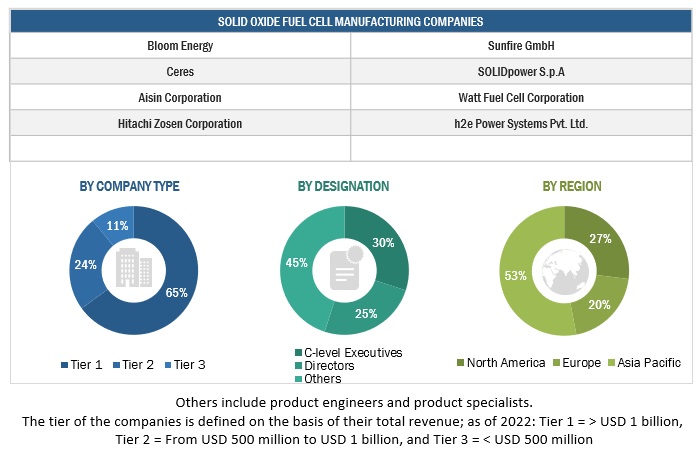
To know about the assumptions considered for the study, download the pdf brochure
Market Size Estimation
Both top-down and bottom-up approaches were used to estimate and validate the total size of the solid oxide fuel cell market. These methods were also used extensively to estimate the size of various subsegments in the market. The research methodology used to estimate the market size includes the following:
- The key players in the industry and market have been identified through extensive secondary research, and their market share has been determined through primary and secondary research.
- The industry’s value chain and market size, in terms of value, have been determined through both primary and secondary research processes.
- All percentage shares, splits, and breakdowns have been determined using secondary sources and verified through primary sources.
Solid Oxide Fuel Cell Market Size: Top-Down Approach

To know about the assumptions considered for the study, Request for Free Sample Report
Data Triangulation
After arriving at the overall market size from the above estimation process, the total market has been split into several segments and subsegments. Data triangulation and market breakdown processes have been employed to complete the overall market engineering process and arrive at the exact statistics for all the segments and sub-segments, wherever applicable. The data has been triangulated by studying various factors and trends from both the demand- and supply sides. Along with this, the market has been validated using both the top-down and bottom-up approaches.
Market Definition
A solid oxide fuel cell (SOFC) is an electrochemical energy conversion device that generates power directly from fuel oxidation. During the electrochemical conversion, a solid or ceramic electrolyte material is inserted between the anode and cathode electrodes. This conversion technique directly generates power by oxidizing a fuel. SOFCs can also be considered as a form of flow battery as they continue to produce energy if the fuel is available and does not need to be recharged. In the market estimation, we have considered the system and the balance of plant costs.
The growth of the solid oxide fuel cell market during the forecast period can be attributed to the rising demand for backup power solutions in the commercial & industrial sector.
Key Stakeholders
- Ceramic and electrolyte manufacturers
- Environmental research institutes
- Fuel cell and stack manufacturers
- Government and research organizations
- Institutional investors/shareholders
- Power and energy associations
- Repair and maintenance service providers
- SOFC technology manufacturing companies
- Organizations, forums, alliances, and associations
- Research and consulting companies
- State and national regulatory authorities
Objectives of the Study
- To describe, segment, and forecast the solid oxide fuel cell market, by type, component, application, and end user, in terms of value
- To forecast the solid oxide fuel cell market, by type, in terms of volume
- To forecast the market across four key regions, namely, North America, Europe, Asia Pacific, and Rest of the World (RoW), along with country-level analysis
- To provide detailed information about key drivers, restraints, opportunities, and challenges influencing the solid oxide fuel cell market
- To strategically analyze the solid oxide fuel cell market with respect to individual growth trends, prospects, and contributions of each segment to the market
- To analyze the supply chain, trends/disruptions impacting customer business, market/ecosystem, pricing trends, and regulatory landscape pertaining to solid oxide fuel cells
Available Customizations:
With the given market data, MarketsandMarkets offers customizations according to the specific requirements of companies. The following customization options are available for the report:
Product Analysis
- Product Matrix, which provides a detailed comparison of the product portfolio of each company
Company Information
- Detailed analyses and profiling of additional market players



 Generating Response ...
Generating Response ...








Growth opportunities and latent adjacency in Solid Oxide Fuel Cell Market
What are the key technological and market trends shaping the global solid oxide fuel cell market?